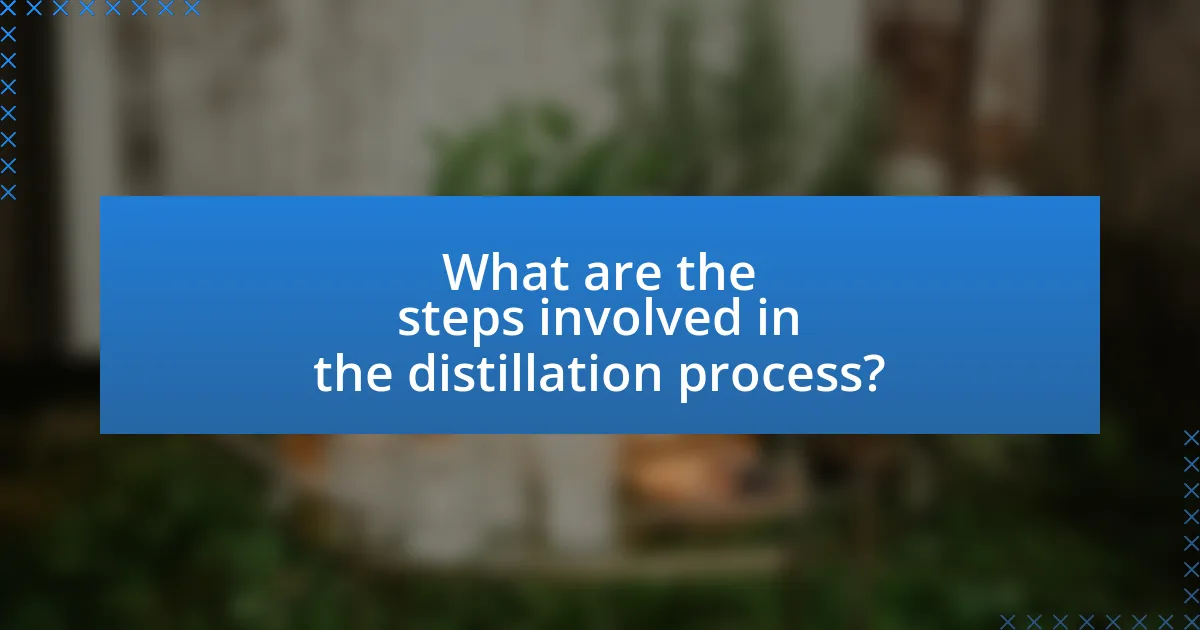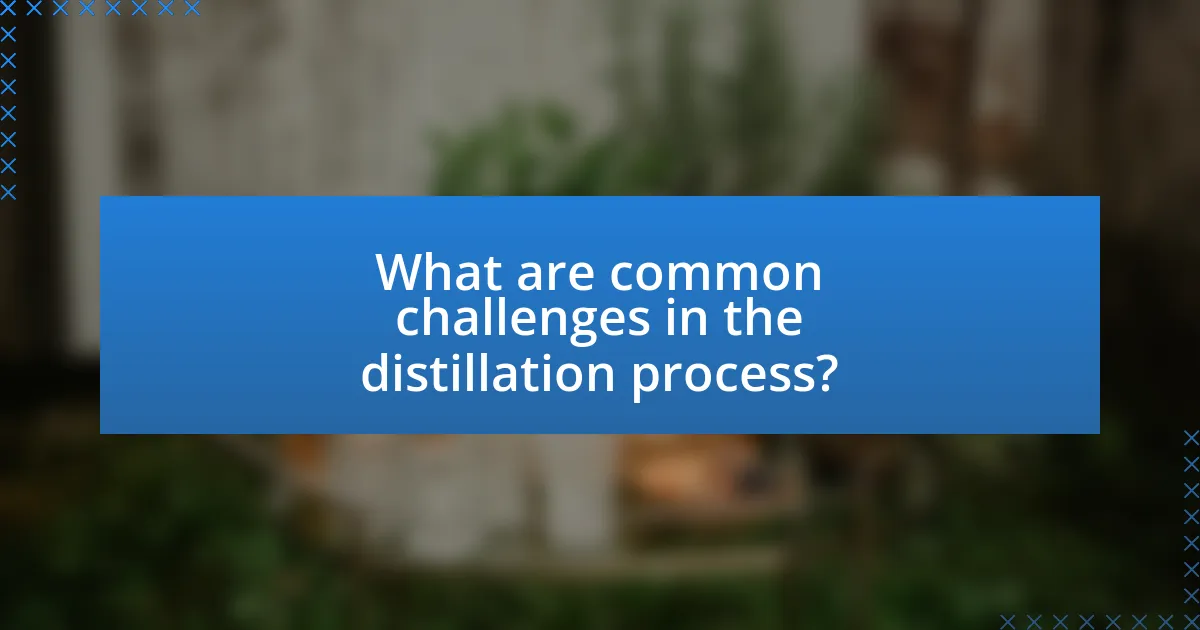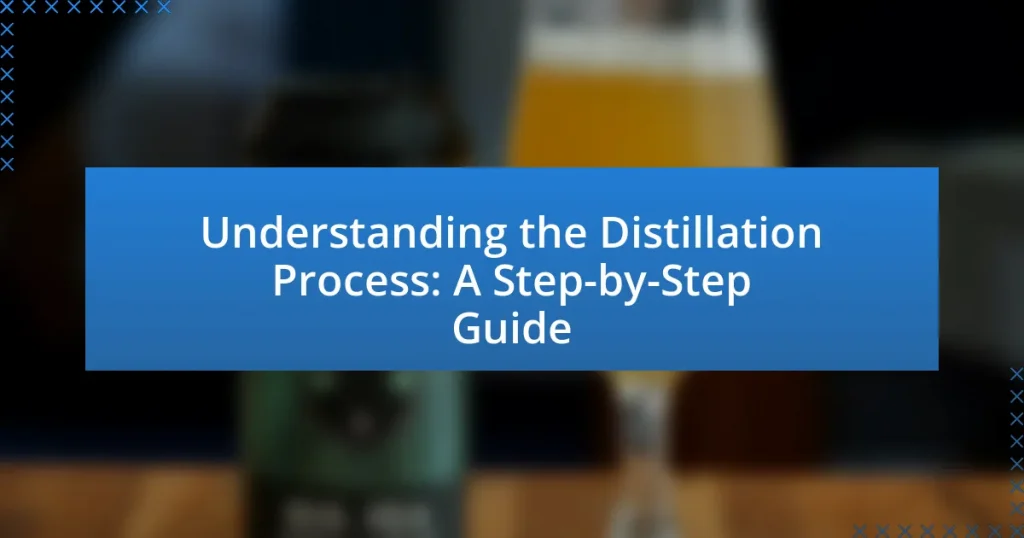The article provides a comprehensive overview of the distillation process, a critical technique for purifying liquids by exploiting differences in boiling points. It details the operational mechanics of distillation, including key components of the apparatus, the influence of temperature and pressure, and various types of distillation such as simple, fractional, steam, and vacuum distillation. Additionally, the article addresses the applications of distillation in industries like petrochemicals and alcohol production, outlines best practices for successful distillation, and discusses common challenges and troubleshooting methods to enhance efficiency and product quality.

What is the Distillation Process?
The distillation process is a separation technique used to purify liquids by heating them to create vapor and then cooling the vapor to form a liquid. This method exploits differences in boiling points of components in a mixture, allowing for the effective separation of substances. For example, in the distillation of crude oil, various hydrocarbons are separated based on their boiling points, resulting in products like gasoline and diesel. The effectiveness of distillation is evidenced by its widespread use in industries such as petrochemicals, pharmaceuticals, and food processing, where purity and concentration of liquids are critical.
How does the distillation process work?
The distillation process works by heating a liquid to create vapor and then cooling that vapor to collect it as a liquid. This method separates components based on differences in boiling points, allowing for the purification of liquids. For example, in the distillation of ethanol from a fermentation mixture, the ethanol vaporizes at a lower temperature than water, enabling its collection as a more concentrated liquid. This technique is widely used in industries such as alcohol production and petroleum refining, where specific components need to be isolated efficiently.
What are the key components of the distillation apparatus?
The key components of the distillation apparatus include a distillation flask, a heat source, a condenser, a receiving flask, and a thermometer. The distillation flask holds the liquid mixture to be separated, while the heat source provides the necessary energy to vaporize the liquid. The condenser cools the vapor back into liquid form, allowing it to be collected in the receiving flask. The thermometer monitors the temperature of the vapor, ensuring accurate separation based on boiling points. Each component plays a crucial role in the efficiency and effectiveness of the distillation process.
How do temperature and pressure influence distillation?
Temperature and pressure significantly influence the distillation process by affecting the boiling points of the substances being separated. Higher temperatures increase the vaporization rate of the liquid, allowing components with lower boiling points to evaporate more readily. Conversely, increased pressure raises the boiling points of liquids, which can enhance the separation of components with closer boiling points by preventing premature vaporization. For instance, in vacuum distillation, reduced pressure lowers boiling points, enabling the distillation of heat-sensitive materials without decomposition. This relationship between temperature, pressure, and boiling points is fundamental to optimizing distillation efficiency and achieving desired purity levels in the final product.
What are the different types of distillation?
The different types of distillation include simple distillation, fractional distillation, steam distillation, vacuum distillation, and azeotropic distillation. Simple distillation is used for separating liquids with significantly different boiling points, while fractional distillation is effective for separating mixtures with closer boiling points by using a fractionating column. Steam distillation is utilized for temperature-sensitive materials, allowing the extraction of essential oils without decomposition. Vacuum distillation lowers the boiling points of substances by reducing pressure, making it suitable for high-boiling compounds. Azeotropic distillation is employed to separate azeotropes, which are mixtures that exhibit constant boiling points. Each type serves specific purposes in chemical processes and industries, demonstrating the versatility of distillation techniques.
What is simple distillation and when is it used?
Simple distillation is a separation technique used to purify liquids by heating them to create vapor and then cooling the vapor to collect the liquid. This method is typically employed when separating a liquid from non-volatile impurities or when the boiling points of the components differ significantly, usually by at least 25 degrees Celsius. Simple distillation is commonly used in laboratories and industries for processes such as purifying water, separating alcohol from fermentation mixtures, and isolating essential oils from plant materials.
How does fractional distillation differ from simple distillation?
Fractional distillation differs from simple distillation in that it is designed to separate mixtures of liquids with closer boiling points more effectively. Simple distillation is suitable for separating components with significantly different boiling points, typically greater than 25 degrees Celsius, while fractional distillation employs a fractionating column that allows for multiple vaporization-condensation cycles, enhancing the separation of components with boiling points that are relatively close together, often within a few degrees. This method is commonly used in industries such as petrochemical refining, where complex mixtures require precise separation of various hydrocarbons.
What is steam distillation and its applications?
Steam distillation is a separation process that utilizes steam to extract volatile compounds from a mixture, primarily used for isolating essential oils from plant materials. This method operates by passing steam through the plant material, causing the essential oils to evaporate and then condense back into liquid form, allowing for efficient extraction without high temperatures that could degrade sensitive compounds. Applications of steam distillation include the production of essential oils for aromatherapy, flavoring in food and beverages, and the extraction of fragrances in the cosmetic industry. The technique is favored for its ability to preserve the integrity of heat-sensitive compounds, making it a widely adopted method in both industrial and laboratory settings.
What are the main applications of distillation?
The main applications of distillation include the purification of liquids, separation of liquid mixtures, and the production of essential oils and alcoholic beverages. Distillation is widely used in the petrochemical industry to separate crude oil into various fractions such as gasoline, diesel, and kerosene. Additionally, it is employed in the production of spirits, where fermentation products are distilled to achieve desired alcohol concentrations. In the pharmaceutical industry, distillation is crucial for isolating active ingredients and solvents. These applications demonstrate distillation’s significance in various sectors, confirming its role as a fundamental separation technique.
How is distillation used in the production of alcoholic beverages?
Distillation is used in the production of alcoholic beverages to separate alcohol from fermented liquids based on differences in boiling points. During distillation, the fermented mixture is heated, causing the alcohol to vaporize, while other components remain in liquid form. The vapor is then collected and cooled, condensing it back into liquid alcohol, which results in a higher concentration of alcohol compared to the original mixture. This process is essential for producing spirits like whiskey, vodka, and rum, where the desired alcohol content is significantly higher than that of the initial fermentation. Distillation can also involve multiple stages, enhancing purity and flavor profiles, which is a common practice in the production of high-quality spirits.
What role does distillation play in the petrochemical industry?
Distillation is a critical process in the petrochemical industry, primarily used for separating and purifying various hydrocarbon components from crude oil. This separation occurs based on differences in boiling points, allowing for the extraction of valuable products such as gasoline, diesel, and jet fuel. The effectiveness of distillation is evidenced by its widespread application in refineries, where it accounts for approximately 90% of the separation processes used to convert crude oil into usable fuels and chemicals.

What are the steps involved in the distillation process?
The steps involved in the distillation process include heating the liquid mixture, vaporizing the components, condensing the vapor back into liquid, and collecting the distilled liquid. Initially, the mixture is heated in a distillation apparatus, causing the component with the lower boiling point to vaporize first. This vapor then travels through a condenser, where it cools and reverts to liquid form. Finally, the condensed liquid is collected in a separate container, effectively separating it from the original mixture. This method is widely used in industries such as petrochemicals and alcohol production, demonstrating its effectiveness in purifying and separating substances based on boiling points.
How do you prepare for distillation?
To prepare for distillation, first ensure that all necessary equipment is clean and assembled, including the distillation flask, condenser, and receiving flask. Proper preparation involves checking for leaks in the apparatus and ensuring that the heat source is functional. Additionally, the mixture to be distilled should be accurately measured and placed in the distillation flask, with any required additives included. This preparation is crucial because contamination or improper setup can lead to inaccurate results or hazardous situations.
What materials are needed for a successful distillation?
For a successful distillation, essential materials include a distillation apparatus, heat source, and a receiving container. The distillation apparatus typically consists of a flask, condenser, and thermometer, which work together to separate components based on boiling points. A heat source, such as a Bunsen burner or heating mantle, is necessary to vaporize the liquid. The receiving container collects the distilled liquid, ensuring proper separation and collection of the desired product. These components are critical for achieving effective separation and purification during the distillation process.
How do you set up the distillation apparatus correctly?
To set up the distillation apparatus correctly, first assemble the key components: a distillation flask, a heat source, a condenser, and a receiving flask. The distillation flask should be securely connected to the heat source, ensuring it is stable and can withstand the heat. The condenser must be attached to the distillation flask, with the water inlet at the bottom and the outlet at the top to facilitate proper cooling. Finally, position the receiving flask at the end of the condenser to collect the distilled liquid. This setup allows for efficient separation of components based on boiling points, a fundamental principle of distillation.
What are the key stages of the distillation process?
The key stages of the distillation process are heating, vaporization, condensation, and collection. In the heating stage, the mixture is heated to a temperature where the component with the lower boiling point vaporizes. During vaporization, the vapor rises through a column or container. In the condensation stage, the vapor cools and transforms back into liquid form, typically in a condenser. Finally, in the collection stage, the condensed liquid, known as distillate, is collected for further use or analysis. These stages are essential for separating components based on their boiling points, a principle widely utilized in various industries, including chemical manufacturing and beverage production.
What happens during the heating phase?
During the heating phase of distillation, the mixture is heated to a temperature that causes the more volatile components to vaporize. This process involves the application of heat, which increases the kinetic energy of the molecules in the liquid, leading to the transition of these components from liquid to gas. The specific temperature at which this occurs depends on the boiling points of the substances present in the mixture, with the more volatile substances vaporizing first. This phase is critical for separating components based on their differing boiling points, a fundamental principle of distillation.
How is the vapor collected and condensed?
Vapor is collected and condensed through a process involving a condenser, which cools the vapor back into liquid form. During distillation, the vapor rises from the boiling liquid and enters the condenser, where it encounters cooler surfaces. This temperature difference causes the vapor to lose heat and transition back into a liquid state, effectively separating it from other components in the mixture. The efficiency of this process is supported by the principles of thermodynamics, which dictate that heat transfer occurs from a hotter substance to a cooler one, facilitating the condensation of vapor into liquid.
What factors can affect the efficiency of distillation?
The efficiency of distillation can be affected by several factors, including temperature, pressure, and the composition of the mixture being distilled. Temperature influences the vaporization rate of the components; higher temperatures generally increase efficiency by enhancing the separation of volatile substances. Pressure also plays a critical role; altering pressure can change boiling points, which can optimize the distillation process for specific mixtures. Additionally, the composition of the mixture, such as the presence of azeotropes, can complicate separation and reduce efficiency. For instance, mixtures that form azeotropes cannot be separated by simple distillation due to their constant boiling composition.
How does the purity of the starting material impact the process?
The purity of the starting material significantly impacts the distillation process by influencing the efficiency and effectiveness of separation. High-purity starting materials lead to fewer impurities in the distillate, resulting in a more refined product and reducing the need for additional purification steps. Conversely, lower purity can introduce unwanted components that complicate the separation, potentially leading to lower yields and increased operational costs. For instance, in a study published in the Journal of Chemical Engineering, it was demonstrated that a starting material with 95% purity yielded a distillate with 90% purity, while a starting material with 99% purity resulted in a distillate with 98% purity, highlighting the direct correlation between starting material purity and the quality of the final product.
What role does the cooling system play in distillation efficiency?
The cooling system is crucial for distillation efficiency as it condenses vapor back into liquid, allowing for the separation of components based on boiling points. Effective cooling ensures that the vapor is efficiently converted to liquid, maximizing the recovery of desired products and minimizing losses. For instance, in a typical distillation setup, a well-functioning condenser can achieve over 90% recovery of the distillate, demonstrating its importance in maintaining high efficiency throughout the process.

What are common challenges in the distillation process?
Common challenges in the distillation process include temperature control, separation efficiency, and equipment fouling. Temperature control is critical because fluctuations can lead to incomplete separation of components, affecting product purity. Separation efficiency can be hindered by factors such as the formation of azeotropes, which complicate the distillation of mixtures with similar boiling points. Equipment fouling occurs when impurities accumulate on heat exchangers and other surfaces, reducing heat transfer efficiency and increasing operational costs. These challenges can significantly impact the overall effectiveness and economic viability of the distillation process.
What issues can arise during distillation?
Issues that can arise during distillation include temperature control problems, contamination, and equipment malfunctions. Temperature control problems can lead to incomplete separation of components, resulting in lower purity of the distillate. Contamination can occur if impurities enter the system, affecting the quality of the final product. Equipment malfunctions, such as leaks or blockages, can disrupt the distillation process and lead to safety hazards or product loss. These issues highlight the importance of precise monitoring and maintenance in distillation operations.
How can foaming affect the distillation process?
Foaming can significantly disrupt the distillation process by causing operational inefficiencies and product contamination. When foaming occurs, it can lead to the overflow of liquid from the distillation column, which results in the loss of valuable components and reduces the overall yield. Additionally, foaming can impede the separation of components by creating a barrier that prevents effective vapor-liquid contact, thus lowering the purity of the distillate. Studies have shown that foaming is often exacerbated by the presence of surfactants or impurities in the feed, which can stabilize the foam and make it more difficult to control.
What are the consequences of improper temperature control?
Improper temperature control during distillation can lead to several significant consequences, including product contamination, reduced yield, and inefficient separation of components. When temperature is not maintained within the optimal range, volatile compounds may not evaporate or condense correctly, resulting in a mixture that contains undesired impurities. For instance, if the temperature is too high, it can cause thermal degradation of sensitive compounds, leading to off-flavors or toxic byproducts. Additionally, improper temperature management can result in lower overall distillation efficiency, as the desired fractions may not be effectively separated, ultimately affecting the quality and purity of the final product.
What are best practices for successful distillation?
Best practices for successful distillation include maintaining optimal temperature control, ensuring proper equipment cleanliness, and selecting suitable distillation techniques. Optimal temperature control is crucial as it affects the separation efficiency of components; for instance, maintaining a steady boiling point can enhance purity. Clean equipment prevents contamination, which can compromise the quality of the distillate. Additionally, choosing the right distillation method—such as fractional distillation for complex mixtures—ensures effective separation based on boiling points. These practices are supported by industry standards that emphasize the importance of precision and cleanliness in achieving high-quality distillates.
How can you ensure safety during the distillation process?
To ensure safety during the distillation process, implement proper ventilation and use appropriate personal protective equipment (PPE). Adequate ventilation minimizes the accumulation of flammable vapors, reducing the risk of fire or explosion. PPE, such as gloves, goggles, and lab coats, protects individuals from chemical exposure and potential burns. Additionally, using equipment designed for distillation, such as explosion-proof heaters and pressure relief valves, further enhances safety by preventing equipment failure and managing pressure build-up. These measures are supported by safety guidelines from organizations like the Occupational Safety and Health Administration (OSHA), which emphasize the importance of risk assessment and hazard control in laboratory settings.
What tips can improve the quality of the distillate?
To improve the quality of the distillate, maintain precise temperature control during the distillation process. This ensures that only the desired compounds are vaporized and condensed, minimizing impurities. For instance, maintaining a steady temperature allows for the separation of volatile components, which can enhance the flavor and aroma of the final product. Additionally, using high-quality raw materials contributes significantly to the purity of the distillate, as impurities in the starting materials can carry over into the final product. Regularly cleaning and maintaining distillation equipment also prevents contamination and buildup that can affect the quality of the distillate.
What troubleshooting steps can be taken in distillation?
To troubleshoot issues in distillation, operators should first check the temperature readings to ensure they align with expected values for the specific components being separated. If the temperature is too low, it may indicate insufficient heat input, while a temperature that is too high could suggest a malfunction in the condenser or excessive heat input. Next, inspecting the reflux ratio is crucial; an improper ratio can lead to poor separation efficiency. Adjusting the reflux can help optimize the distillation process. Additionally, examining the feed composition is essential, as variations can affect the distillation outcome. If the feed contains unexpected impurities, it may require pre-treatment or adjustment of the distillation parameters. Lastly, ensuring that all equipment is clean and functioning properly is vital, as fouling or blockages can severely impact performance. Regular maintenance and calibration of instruments can prevent many common issues in distillation.
How do you address low yield in distillation?
To address low yield in distillation, optimize the distillation parameters such as temperature, pressure, and reflux ratio. Adjusting these factors can enhance separation efficiency and increase the amount of desired product collected. For instance, maintaining an appropriate reflux ratio ensures that the vapor phase is adequately enriched in the more volatile components, which can significantly improve yield. Additionally, using high-quality feedstock and ensuring proper equipment maintenance can prevent losses due to impurities and operational inefficiencies.
What should you do if the distillate has an undesirable odor?
If the distillate has an undesirable odor, you should discard it. Distillates with off-putting smells often indicate contamination or improper distillation, which can compromise safety and quality. For instance, the presence of certain volatile compounds can lead to undesirable odors, signaling that the distillation process may not have been executed correctly. Therefore, it is crucial to ensure that only distillates with acceptable sensory characteristics are retained for use.


